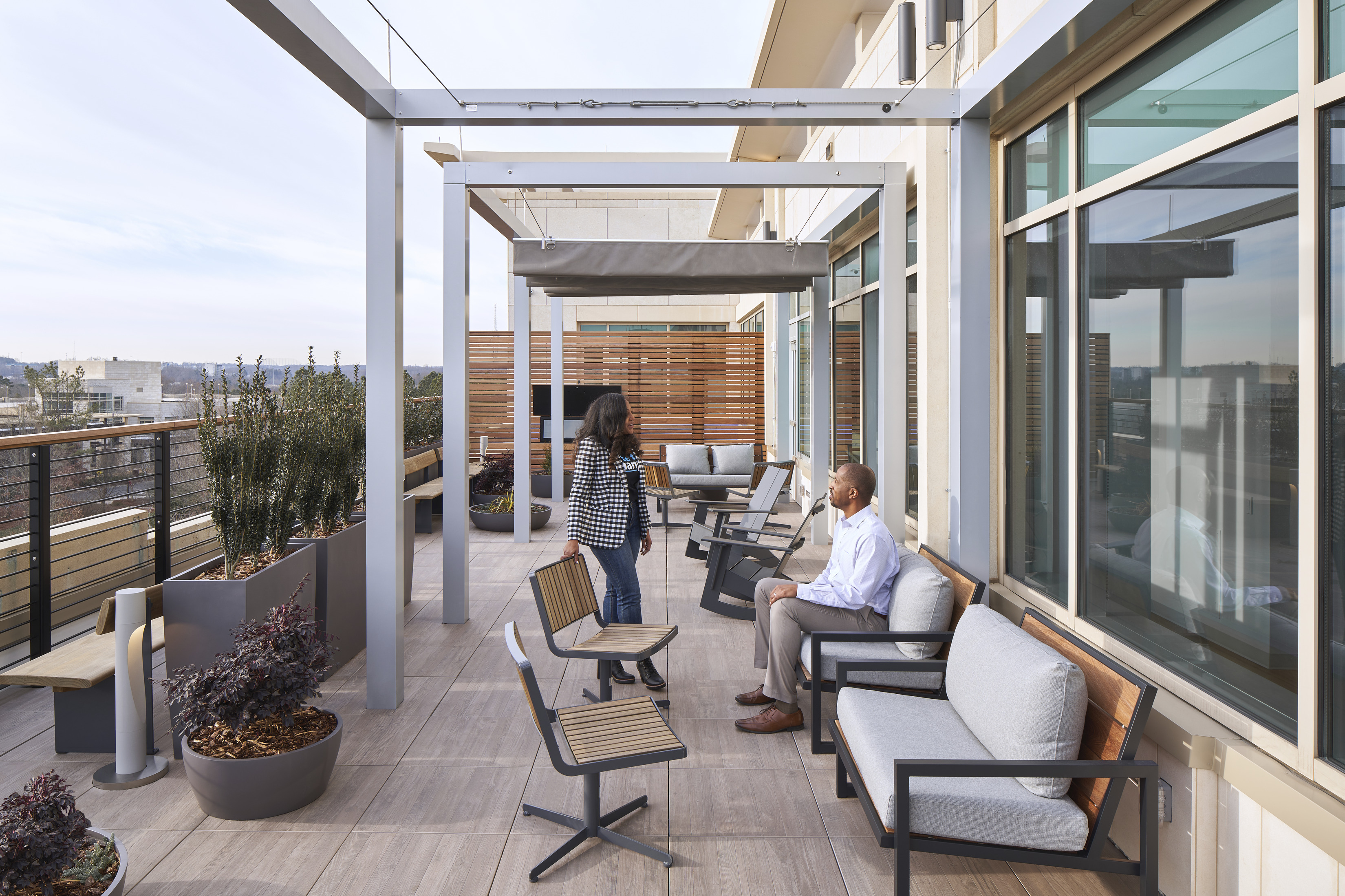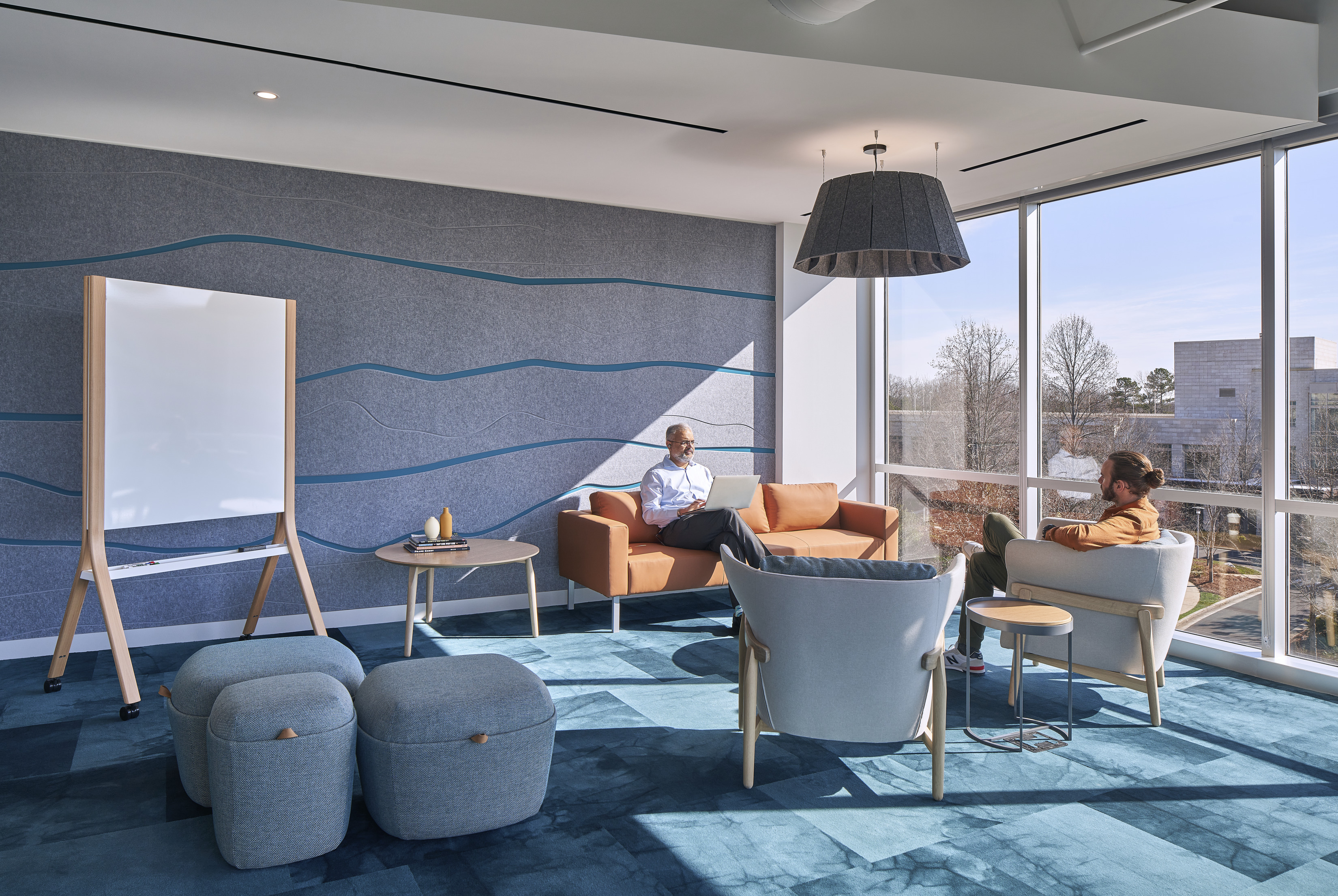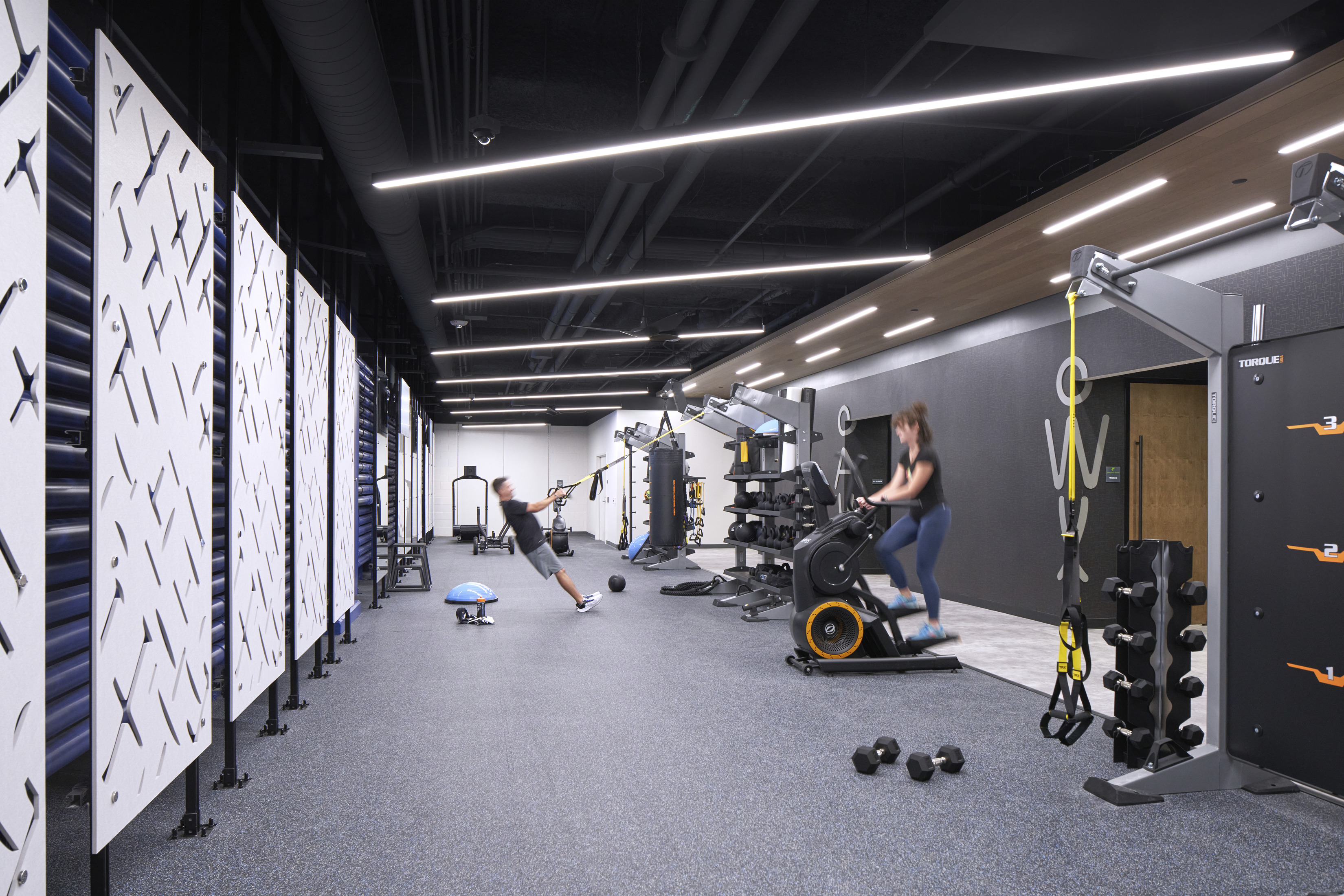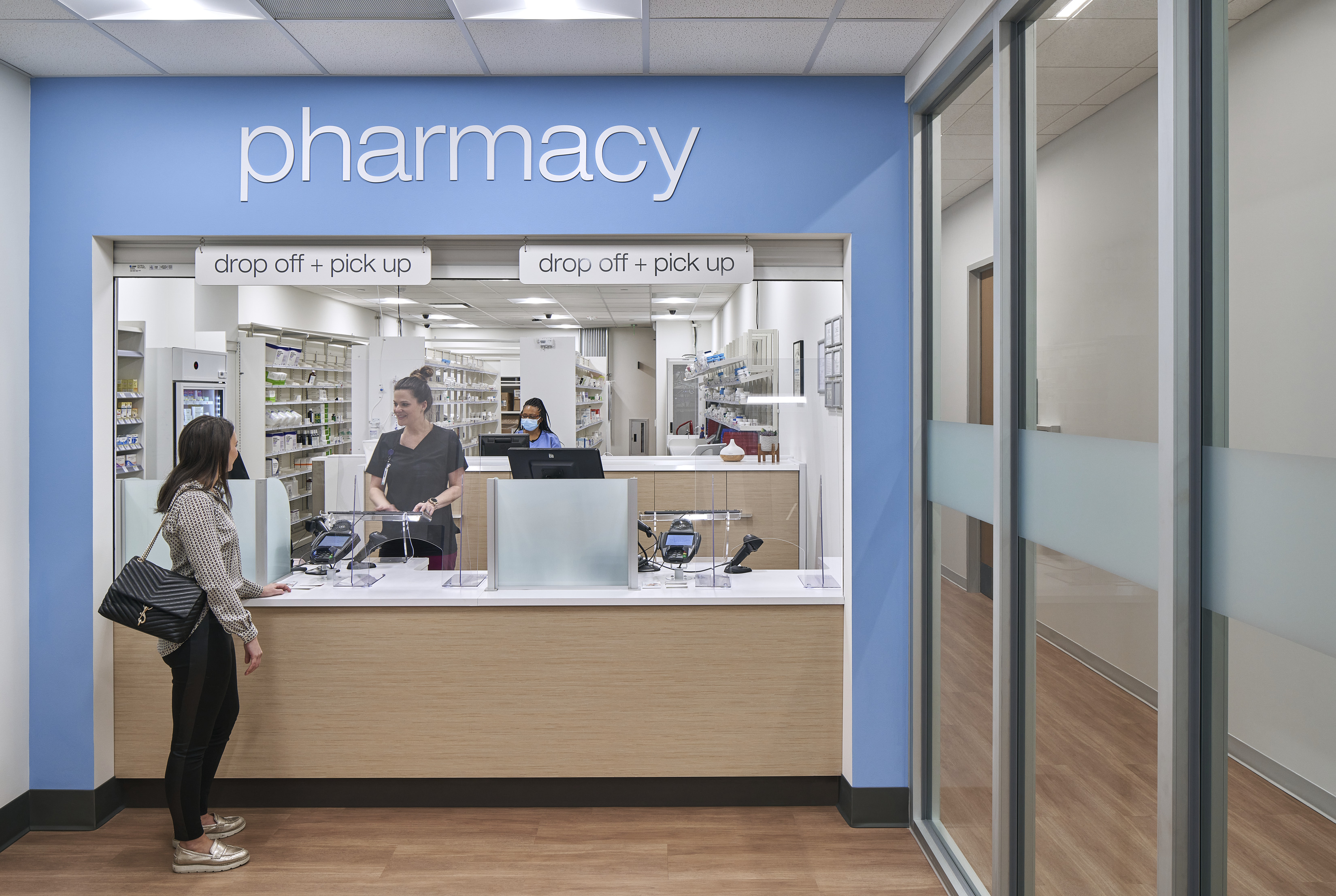This summer, the financial-services firm Teachers Insurance and Annuity Association will open the doors to a campus that feels a lot like a public park, with walking trails, a disc golf course, putting greens, bocce ball courts, pickleball courts, and a basketball court. As companies lean harder into in-office amenities to attract and retain talent, TIAA has updated its Charlotte, North Carolina, offices with a specific goal in mind: to emphasize employees’ physical and mental wellness.
Spanning 92 acres—for comparison, that’s eight acres shy of Disneyland’s 100—the campus’s new resources also include a redesigned food hall, a fitness center, and a pharmacy, as well as new workspaces for individual and collaborative work.
Founded by Andrew Carnegie in 1918, TIAA provides wealth-management services to over 5 million clients, largely in the academic, government, medical and other non-profit fields. The Charlotte campus, built in 2000, is one of the company’s four major offices, including its Manhattan headquarters. Some 5,000 employees now work in the campus’s 989,000 square feet of office space, split across 24 floors in six buildings.
With the remodel now two-thirds of the way complete, the company is staggering its move-in process until construction finishes in late summer 2022. Teams whose assigned floors have been completed have already returned to the office part-time. Others are still largely remote while their floors remain under construction, but are able to come onto the campus to meet with coworkers, work in temporary co-working spaces, and access the new amenities.
The problem: Designing enduring spaces during an unprecedented moment
By March 2020, TIAA and their team of architects at Interior Architects had finalized their workplace strategy and general plan for the redesign, which included an increased number of meeting spaces, new places for gathering and collaboration, and expanded amenities such as a fitness center and revamped food hall.
The goal was to overhaul a workplace that hadn’t had a major renovation since it was first built two decades prior. “It needed to have some longevity to it,” says Stephanie Schmitz, a principal at Interior Architects. “They wanted to design a workplace that would take them into the future, so they won’t need to have plans to renovate every five years.”
Then the pandemic began. The company had to pivot to working remotely, and the design team had a new question to answer: How do you design for an unprecedented—and unpredictable—pandemic, while creating spaces that would endure long into the future?
The opportunity: A chance to rethink wellness on campus
Even before the pandemic, “wellness was one of our guiding principles,” says Jennifer Cline, TIAA’s head of workplace strategy and execution. Their campus already had an on-site health service center, staffed by doctors and nurses, and pre-pandemic plans included adding a new fitness center for employees.
As Covid-19 spread in their community, however, the role of health and wellness in their design took on new importance:. A successful office return depended on creating a workplace where employees would feel safe, healthy, and supported. It required spaces that could adapt with physical distancing requirements and provide access to fresh air and the outdoors.
“What really shifted with the pandemic was our focus on our outdoor spaces and amenities—this was something that was not in scope for us pre-pandemic,” says Cline, adding that “we have 92 acres of campus, but for the past 20 years, no one used those spaces.”
The process: A focus on flexibility
Throughout the summer of 2020, TIAA and their design team overhauled their plans for the redesign with a new guiding principle: flexibility.
With employees now used to the freedom of remote work, TIAA hoped to allow similar movement and choice throughout the workday while at the office. “We encouraged mobility throughout the campus,” says Stephanie Schmitz, adding that their new focus on outdoor spaces encouraged “utilizing the campus as a whole, not just the buildings.”
The same approach guided their new plans for indoor spaces as well. “We have flexible furniture—things that can be adjusted and moved,” says Cline. We’ve implemented technologies to measure quantitatively how our spaces are used so that we can be flexible and make informed decisions.”
The result: 92 acres for work, play, and wellness
All the new indoor amenities are finished and open to staff, but construction continues on many of the workspaces and the outdoor grounds, which are set to be completed this summer.
While the campus’s new outdoor amenities “are recreational by nature,” says Cline, “the business justification was that they will create more opportunities for collaboration, for team building, and for integrating the outdoors into the workday.”

Even as construction crews continue to work on the grounds, new indoor spaces maintain employees’ connection to the outdoors through terraces and abundant natural daylight.

Each floor within each of the campus’s six buildings features spaces dedicated to wellness, both physical and mental: a mindfulness room, where employees can reserve space for prayer, meditation, or a quick yoga flow; a mothers’ room for nursing parents; and multiple hygiene stations stocked with hand sanitizer, masks, and disinfectant wipes.

And then there’s the gym. TIAA’s new 11,000 square foot gym was always part of the campus redesign plan, but the pandemic—and the organization’s new emphasis on flexibility—has changed how employees use it.

“Before, the broad expectation was that if you wanted to use the gym, you would come in an hour early, go during lunch, or stay a little later in the evening,” says Cline. “It has shifted to be more integrated into the workday—go hit the treadmill when you need to work out a problem in your head. It’s not about work-life balance. It’s about work-life integration.”

One of the most unique amenities TIAA has added is access to an on-site, fully-stocked pharmacy, where employees can pick up both over-the-counter medications and prescriptions. The addition of a pharmacy “complemented our existing amenities,” explains Cline. “We already had onsite doctors and nurses, but it still could be difficult to go pick up your prescription before or after work because of pharmacies’ hours.”

Advice: Design flexible spaces that can change over time
For leaders considering their own campus redesigns, Cline has a piece of advice: “You have to build to evolve. We don’t want to have to tear down and rebuild this again and again.”
To Cline, creating a space that can rise to meet new needs is key to investing in a changing workforce. “The employee is at the center of it,” she says. “It needs to not only make fiscal sense, but [workplaces] have to work for them. As their preferences change, and as we bring in more Gen Zers, we need to be able to adapt.”